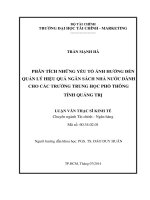Kaplan GMAT math workbook sixth edition
Bạn đang xem bản rút gọn của tài liệu. Xem và tải ngay bản đầy đủ của tài liệu tại đây (8.7 MB, 338 trang )
GMAT®
MATHWORKBOOK
SixthEdition
ThestaffofKaplanTestPrepandAdmissions
CONTENTS
HowtoUseThisBook
ASpecialNoteforInternationalStudents
PARTONE:GETTINGSTARTED
Chapter1.IntroductiontoGMATMath
PARTTWO:MATHCONTENTREVIEW
Chapter2.Arithmetic
Chapter3.Algebra
Chapter4.Geometry
PARTTHREE:QUESTIONTYPEREVIEW
Chapter5.WordProblems
Chapter6.DataSufficiencyQuestions
OtherKaplanTitlesonBusinessSchoolAdmissions
AboutthePublisher
HowtoUseThisBook
Kaplan has prepared students to take standardized tests for more than 50 years—longer than the
GMAThasevenbeenaround.Ourteamofresearchersandeditorsknowmoreaboutpreparation
for the GMAT than anyone else, and you’ll find their accumulated knowledge and experience
throughoutthisbook.
TheGMATisastandardizedtest,andso,whilenotwotestadministrationsareidentical,theyall
coverthesamecontent.Thisisgoodnewsforyou;itmeansthatthebestpreparationyoucanhave
willfocusonthesortofquestionsyouarelikelytoseeontestday.Alloftheexercisesinthisbook
aremadeupofsuchquestions.
Themainfocusofthisbookisonreviewingthemathconceptsyouneedtogetagoodscoreonthe
GMAT.Strategicreviews,exercises,andpracticetestswithexplanationswillhelpyoubrushupon
anymathskillsyouhaveforgottensincehighschool.
Ifpossible,workthroughthisbookalittleatatimeoverthecourseofseveralweeks.Thereisalot
ofmathtoabsorb,andit’shardtodoitallatonce.Crammingjustbeforethetestisnotagoodidea
—youprobablywon’tabsorbmuchinformationifyoupackitinatthelastminute.
STEP1:CHECKOUTTHEBASICS
ThefirstthingyouneedtodoisfindoutexactlywhatisonthemathsectionsoftheGMAT.InPart
One, “Getting Started,” you’ll see background information on the quantitative section, what it
covers,andhowit’sorganized.
STEP2:MATHCONTENTREVIEW
Onceyouhavethebigpicture,focusonthecontent.PartTwoofthisbook,“MathContentReview,”
does just that. It gives you a complete tour of the math that you will see on test day. There’s a
chapterforeachofthethreemajorcontentareas—arithmetic,algebra,andgeometry.Sinceeach
chapterbuildsonthematerialinearlierchapters,it’sbesttogoovertheminorder.
Thematerialinthemathcontentreviewisdividedintosubjects.Eachsubjectbeginswithareview,
followedbypracticequestionsorganizedbylevelofdifficulty:basic,intermediate,andadvanced.
This way, you’ll be able to pinpoint the math concepts you need to review and quickly get your
skillsuptospeed.
We suggest that you quickly skim the content review that introduces a section and then try the
exercises.Ifyoufindthemdifficult,gobacktothecontentreviewbeforemovingon.Ifyoudowell
on the exercises, try the basic problem set that follows. Once you are satisfied you have a good
grasponthebasics,trytheintermediateandadvancedproblemsets.Answersandexplanationsfor
the practice problems follow the chapter. Read the explanations to all the questions—even those
you got right. Often the explanations will contain strategies that show you how you could have
gottentotheanswermorequicklyandefficiently.
STEP3:BECOMEFAMILIARWITHTHEGMATQUESTIONTYPES
The GMAT has word problems and an unusual question type: the Data Sufficiency question. It’s
importanttolearnitnow,wellbeforetestday.Youwillbelimitedintimeduringtheactualtest,so
youcannotwastetimethentryingtofigureoutwhatyouarebeingasked.Takethetimetolearnthis
questiontypewell.
Nowyou’rereadytobeginpreparingforthemathsectionoftheGMAT.Goodluck!
GraduateSchoolintheUnitedStates:ASpecialNotefor
InternationalStudents
About 250,000 international students pursue advanced academic degrees at the master ’s or Ph.D.
level at U.S. universities each year. This trend of pursuing higher education in the United States,
particularlyatthegraduatelevel,isexpectedtocontinue.Business,management,engineering,and
thephysicalandlifesciencesarepopularareasofstudyforstudentscomingtotheUnitedStates
from other countries. If you are an international student planning on applying to a graduate
programintheUnitedStates,youwillwanttoconsiderthefollowing.
IfEnglishisnotyourfirstlanguage,youwillprobablyneedtotaketheTestofEnglishasa
ForeignLanguage(TOEFL® )orshowsomeotherevidencethatyou’reproficientinEnglish
priortogainingadmissiontoagraduateprogram.Graduateprogramswillvaryonwhatisan
acceptableTOEFLscore.Fordegreesinbusiness,journalism,management,orthehumanities,
aminimumTOEFLscoreof600(250onthecomputer-basedTOEFL)orbetterisexpected.
Forthehardsciencesandcomputertechnology,aTOEFLscoreof550(213onthecomputerbasedTOEFL)isacommonminimumrequirement.
YoumayalsoneedtotaketheGraduateRecordExam(GRE® )ortheGraduateManagement
AdmissionTest(GMAT ® )aspartoftheadmissionprocess.
Since admission to many graduate programs and business schools is quite competitive, you
maywanttoselectthreeorfourprogramsyouwouldliketoattendandcompleteapplications
foreachprogram.
Selectingthecorrectgraduateschoolisverydifferentfromselectingasuitableundergraduate
institution. You should research the qualifications and interests of faculty members teaching
anddoingresearchinyourchosenfield.Lookforprofessorswhoshareyourspecialty.Also,
select a program that meets your current or future employment needs, rather than simply a
programwithabigname.
You need to begin the application process at least a year in advance. Be aware that many
programsofferonlyAugustorSeptemberstartdates.Findoutapplicationdeadlinesandplan
accordingly.
Finally, you will need to obtain an 1-20 Certificate of Eligibility in order to obtain an F-1
StudentVisatostudyintheUnitedStates.
KAPLANENGLISHPROGRAMS*
If you need more help with the complex process of graduate school admissions, or assistance
preparing for the TOEFL, GRE, or GMAT, you may be interested in Kaplan’s programs for
internationalstudents.KaplanEnglishProgramsweredesignedtohelpstudentsandprofessionals
fromoutsidetheUnitedStatesmeettheireducationalandcareergoals.Atlocationsthroughoutthe
United States, international students take advantage of Kaplan’s programs to help them improve
theiracademicandconversationalEnglishskills,raisetheirscoresontheTOEFL,GRE,GMAT,
andotherstandardizedexams,andgainadmissiontotopprograms.Ourstaffandinstructorsgive
internationalstudentstheindividualizedinstructiontheyneedtosucceed.Hereisabriefdescription
ofsomeofKaplan’sprogramsforinternationalstudents:
GeneralIntensiveEnglish
Kaplan’s General Intensive English classes are designed to help you improve your skills in all
areasofEnglishandtoincreaseyourfluencyinspokenandwrittenEnglish.Classesareavailable
forbeginningtoadvancedstudents,andtheaverageclasssizeis12students.
TOEFLandAcademicEnglish
ThiscourseprovidesyouwiththeskillsyouneedtoimproveyourTOEFLscoreandsucceedinan
American university or graduate program. It includes advanced reading, writing, listening,
grammar,andconversationalEnglish.YouwillalsoreceivetrainingfortheTOEFLusingKaplan’s
exclusivecomputer-basedpracticematerials.
GREforInternationalStudents
The Graduate Record Exam (GRE) is required for admission to many graduate programs in the
UnitedStates.Nearlyone-halfmillionpeopletaketheGREeachyear.Ahighscorecanhelpyou
standoutfromothertesttakers.Thiscourse,designedespeciallyfornon-nativeEnglishspeakers,
includestheskillsyouneedtosucceedoneachsectionoftheGRE,aswellasaccesstoKaplan’s
exclusivecomputer-basedpracticematerialsandextraverbalpractice.
GMATforInternationalStudents
TheGraduateManagementAdmissionsTest(GMAT)isrequiredforadmissiontomanygraduate
programsinbusinessintheUnitedStates.HundredsofthousandsofAmericanstudentshavetaken
this course to prepare for the GMAT. This course, designed especially for non-native English
speakers,includestheskillsyouneedtosucceedoneachsectionoftheGMAT,aswellasaccessto
Kaplan’sexclusivecomputer-basedpracticematerialsandextraverbalpractice.
OTHERKAPLANPROGRAMS
Since1938,morethan3millionstudentshavecometoKaplantoadvancetheirstudies,preparefor
entrytoAmericanuniversities,andfurthertheircareers.Inadditiontotheaboveprograms,Kaplan
offers courses to prepare for the SAT ® , LSAT ® , MCAT ® , DAT ® , USMLE® , NCLEX® , and other
standardizedexamsatlocationsthroughouttheUnitedStates.
ApplyingtoKaplanEnglishPrograms
TogetmoreinformationortoapplytoanyofKaplan’sprograms,contactusat:
KaplanEnglishPrograms
700SouthFlower,Suite2900
LosAngeles,CA90017USA
Phone(ifcallingfromwithintheUnitedStates):(800)818-9128
Phone(ifcallingfromoutsidetheUnitedStates):(213)452-5800
Fax:(213)892-1364
Website:www.kaplanenglish.com
Email:
*Kaplanisauthorizedunderfederallawtoenrollnonimmigrantalienstudents.
KaplanisaccreditedbyACCET(AccreditingCouncilforContinuingEducationandTraining).
|PARTONE|
GettingStarted
Chapter1:
IntroductiontoGMATMath
Beenthere,donethat.Ifyou’reconsideringapplyingtobusinessschool,thenyou’vealreadyseen
allthemathyouneedfortheGMAT.Youwouldhavecoveredtherelevantmathcontentinjunior
high.Infact,themaththatappearsontheGMATisalmostidenticaltothemathtestedontheSATor
ACT.Youdon’tneedtoknowtrigonometry.Youdon’tneedtoknowcalculus.Nosurprises—it’s
allmaterialyou’veseenbefore.Theonlyproblemis,youmaynothaveseenitlately.Whenwasthe
lasttimeyouhadtoaddabunchoffractionswithoutacalculator?
Nomatterhowmuchyourmemoriesofjuniorhighalgebraclasseshavedimmed,don’tpanic.The
GMATtestsalimitednumberofcoremathconceptsinpredictableways.Certaintopicscomeupin
everytest,and,chancesare,thesetopicswillbeexpressedinmuchthesameway;evensomeofthe
wordsandphrasesappearinginthequestionsarepredictable.Sincethetestissoformulaic,wecan
showyouthemathyou’reboundtoencounter.Somepracticeontestlikequestions,suchasthosein
thefollowingchapters,willreadyyouforthequestionsyouwillseeontheactualtest.
Hereisachecklistofcoremathconceptsyou’llneedtoknow.Theseconceptsarevital,notonly
becausetheyaretesteddirectlyoneveryGMATadministration,butalsobecauseyouneedtoknow
how to perform these simpler operations in order to perform more complicated tasks. For
instance,youwon’tbeabletofindthevolumeofacylinderifyoucan’tfindtheareaofacircle.
Weknowthemathoperationsonthefollowinglistareprettybasic,butmakesureyouknowhowto
dothem.
GMATMATHBASICS
Add,subtract,multiply,anddividefractions.(Chapter2)
Convertfractionstodecimals,andviceversa.(Chapter2)
Add,subtract,multiply,anddividesignednumbers.(Chapter2)
Plugnumbersintoalgebraicexpressions.(Chapter3)
Solveasimplealgebraicequation.(Chapter3)
Findapercentusingthepercentformula.(Chapter2)
Findanaverage.(Chapter2)
Findtheareasofrectangles,triangles,andcircles.(Chapter4)
HOWMATHISSCOREDONTHEGMAT
TheGMATwillgiveyouascaledquantitativescorefrom0to60.(Theaveragescoreis35.)This
scorereflectsyourperformanceonthemathportionofthetestcomparedtoallotherGMATtest
takers.
You will also receive an overall score that reflects your performance on both the math and the
verbalportionsofthetest.Thisisascaledscorefrom200to800.
TESTOVERVIEW
The GMAT is a Computer Adaptive Test, or CAT. You take this test on a computer at special
centers.Here’saquickoverviewofthemathsection.
Thereare37questionstobedonein75minutes.
Approximately two-thirds of the questions will be in the Problem Solving format, and the
remainingquestionswillbeintheDataSufficiencyformat.
About10ofthequestionsintheGMATCATmathsectionwillbeexperimentalquestions.Theseare
questionsthatarebeingtestedforuseinfuturetests,andarenotscored.However,thereisnoway
of telling the experimental questions from the scored questions around them, and so you should
treatallquestionsasiftheyarescored.
ProblemSolvingQuestions
Problem Solving questions are the simplest type of question. You are given a question (and
sometimesanaccompanyingchartordiagram)andaskedtochoosethecorrectanswerfromalist
offiveanswerchoices.Here’sasampleProblemSolvingquestion.
DataSufficiencyQuestions
InDataSufficiency,aquestionisfollowedbytwostatementscontainingcertaindata.Yourtaskisto
determine whether the data provided by the statements are sufficient to answer the question. All
DataSufficiencyquestionshavethesamefiveanswerchoices.
Here’sasampleDataSufficiencyquestion.
TheDataSufficiencychapterhasmoreexamplesofthosequestions.
MATHCONTENT
GMATmathisbasicallyjuniorhighschoollevelmath,butabitharder.
Arithmetic—Abouthalfofallquestions.
Algebra—Aboutaquarterofallquestions.
Geometry—Aboutasixthofallquestions.
Graphs,logicquestions,andothermiscellaneousquestiontypesoccurfromtimetotime.
Abouthalfofallquestionsarepresentedintheformofwordproblems.
COMPUTERADAPTIVETESTING
TheGMATisalittledifferentfromthepaper-and-penciltestsyouhaveprobablyseeninthepast.
YoumakeyourwaythroughtheGMATCATbypointingandclickingwithamouse—infact,the
tests are mouse-only. You won’t use the keyboard in the math portions of the tests. Each test is
preceded by a short tutorial that will show you exactly how to use the mouse to indicate your
answer and move through the test. If you have used a computer and mouse before, you will
probablyfindtheproceduretobeverysimple.
HowaCATFindsYourScore
Thesecomputer-basedtests“adapt”toyourperformance.Thismeansthequestionsgetharderor
easier depending on whether you answer them correctly or not. Your score is not directly
determinedbyhowmanyquestionsyougetright,butbyhowhardthequestionsyougetrightare.
Whenyoustartasectionthecomputer:
Assumesyouhaveanaveragescore.
Givesyouamedium—difficultyquestion.
Ifyouansweraquestioncorrectly:
Yourscoregoesup.
Youaregivenaharderquestion.
Ifyouansweraquestionincorrectly:
Yourscoregoesdown.
Youaregivenaneasierquestion.
Afterawhileyouwillreachalevelwheremostofthequestionswillseemdifficulttoyou.Atthis
pointyouwillgetroughlyasmanyquestionsrightasyougetwrong.Thisisyourscoringlevel.
Thecomputerusesyourscoringlevelincalculatingyourscaledscore.
Anotherconsequenceofthetest’sadaptivenatureisthatforthebulkofthetestyouwillbegetting
questionsatthelimitofyourability.Whileeveryquestionisequallyimportanttoyourfinalscore,
harderquestionsgeneratehigherscoresandeasierquestionslowerscores.Youwanttoansweras
many hard questions as possible. This is a reason to concentrate your energies on the early
questions.Gettheserightandyouareintotheharderquestions,wherethepointsare.Thesooner
youstarttoseeharderquestions,thehigheryourfinalscoreislikelytobe.
Thereareafewotherconsequencesoftheadaptivenatureofthetestthatyoushouldconsider.
There is no preset order of difficulty; the difficulty level of the questions you’re getting is
dependent on how well you have done on the preceding questions. The harder the questions
are,thebetteryouaredoing.So,ifyouseemtobegettingonlyhardquestions,don’tpanic:
It’sagoodsign!
Onceyouleaveaquestion,youcannotreturntoit.That’sit.Kissitgood-bye.Thisiswhyyou
shouldneverrushontheCAT.Makesurethatyouhaveindicatedtherightanswerbeforeyou
confirmitandmoveon.TheCATrewardsmeticuloustesttakers.
InaCATyoumustansweraquestiontomoveontothenextone.There’snoskippingaround.
If you can’t get an answer, you will have to guess in order to move on. Consequently,
intelligent guessing can make the difference between a mediocre and a great score. Guess
intelligently and strategically—eliminate any answer choices that you can determine are
wrongandguessamongthoseremaining.Theexplanationstothequestionsinthisbookwill
demonstratetechniquesforeliminatinganswerchoicesstrategically.
One final, important point. There is a penalty for unanswered questions on the CAT. Every
questionyouleaveunansweredwilldecreaseyourscorebyagreateramountthanaquestion
thatyouansweredincorrectly!Thismeansthatyoushouldanswerallthequestionsonthetest,
evenifyouhavetoguessrandomlytofinishasection.
|PARTTWO|
MathContentReview
Chapter2:
Arithmetic
Most of the problems you will see on the GMAT involve arithmetic to some extent. Among the
most important topics are number properties, ratios, and percents. You should know most of the
basicdefinitions,suchaswhatanintegeris,whatevennumbersare,etcetera.
Not only do arithmetic topics covered in this unit themselves appear on the exam, they are also
essential for understanding some of the more advanced concepts that will be covered later. For
instance, many of the rules covering arithmetic operations, such as the commutative law, will be
importantwhenwediscussvariablesandalgebraicexpressions.Inaddition,theconceptswecover
herewillbeneededforwordproblems.
NUMBEROPERATIONS
NumberTypes
Thenumbertreeisavisualrepresentationofthedifferenttypesofnumbersandtheirrelationships.
RealNumbers:Allnumbersonthenumberline;allthenumbersontheGMATarereal.
RationalNumbers:Allnumbersthatcanbeexpressedastheratiooftwointegers(allintegersand
fractions).
IrrationalNumbers:Allrealnumbersthatarenotrational,bothpositiveandnegative(e.g.π,
Integers:Allnumberswithnofractionalordecimalparts:multiplesof1.
).
OrderofOperations
PEMDAS = Please Excuse My Dear Aunt Sally—This mnemonic will help you remember the
orderofoperations.
LawsofOperations
Commutative law: Addition and multiplication are both commutative; it doesn’t matter in what
ordertheoperationisperformed.
Example:5+8=8+5;2×6=6×2
Divisionandsubtractionarenotcommutative.
Example:3−2#2−3;6÷2#2÷6
Associative law: Addition and multiplication are also associative; the terms can be regrouped
withoutchangingtheresult.
Distributivelaw:Thedistributivelawofmultiplicationallowsusto“distribute”afactoramong
thetermsbeingaddedorsubtracted.Ingeneral,a(b+c)=ab+ac.
Divisioncanbedistributedinasimilarway.
Don’tgetcarriedaway,though.Whenthesumordifferenceisinthedenominator,nodistribution
ispossible.
Fractions
Equivalentfractions:Thevalueofanumberisunchangedifyoumultiplythenumberby1.Ina
fraction,multiplyingthenumeratoranddenominatorbythesamenonzeronumberisthesameas
multiplyingthefractionby1;thefractionisunchanged.Similarly,dividingthetopandbottomby
thesamenonzeronumberleavesthefractionunchanged.
Cancelingandreducing:Generallyspeaking,whenyouworkwithfractionsontheGMATyou’ll
need to put them in lowest terms. That means that the numerator and the denominator are not
divisiblebyanycommonintegergreaterthan1.Forexample,thefraction isinlowestterms,but
thefraction isnot,since3and6arebothdivisibleby3.
Themethodweusetotakesuchafractionandputitinlowesttermsiscalledreducing.Thatsimply
means to divide out any common multiples from both the numerator and denominator. This
processisalsocommonlycalledcanceling.
Addition and subtraction: We can’t add or subtract two fractions directly unless they have the
same denominator. Therefore, before adding, we must find a common denominator. A common
denominator is just a common multiple of the denominators of the fractions. The least common
denominatoristheleastcommonmultiple(thesmallestpositivenumberthatisamultipleofall
theterms).
Multiplication:
Division:Dividingisthesameasmultiplyingbythereciprocalofthedivisor.Togetthereciprocal
ofafraction,justinvertitbyinterchangingthenumeratorandthedenominator.Forexample,the
reciprocalofthefraction is .
Complex fractions: A complex fraction is a fraction that contains one or more fractions in its
numeratorordenominator.Therearetwowaystosimplifycomplexfractions.
Method I: Use the distributive law. Find the least common multiple of all the denominators, and
multiplyallthetermsinthetopandbottomofthecomplexfractionbytheLCM.Thiswilleliminate
allthedenominators,greatlysimplifyingthecalculation.
Method II: Treat the numerator and denominator separately. Combine the terms in each to get a
single fraction on top and a single fraction on bottom. We are left with the division of two
fractions,whichweperformbymultiplyingthetopfractionbythereciprocalofthebottomone.
ThismethodispreferablewhenitisdifficulttogetanLCMforallthedenominators.
Comparing positive fractions: If the numerators are the same, the fraction with the smaller
denominator will have the larger value, since the numerator is divided into a smaller number of
parts.
Ifthedenominatorsarethesame,thefractionwiththelargernumeratorwillhavethelargervalue.
Ifneitherthenumeratorsnorthedenominatorsarethesame,expressallofthefractionsintermsof
somecommondenominator.Thefractionwiththelargestnumeratorwillbethelargest.
Noticethatitisnotnecessarytocalculatethedenominators.Ashorterversionofthismethodisto
multiplythenumeratoroftheleftfractionbythedenominatoroftherightfractionandviceversa
(cross-multiply).Thencomparetheproductsobtainedthisway.Iftheleftproductisgreater,then
theleftfractionwasgreatertostartwith.
Sometimes it is easier to find a common numerator. In this case, the fraction with the smaller
denominatorwillbethelargerfraction.
Mixed Numbers: Mixed Numbers are numbers consisting of an integer and a fraction. For
example,
,and areallmixednumbers.Fractionswhosenumeratorsaregreaterthantheir
denominatorsmaybeconvertedintomixednumbers,andviceversa.
DecimalFractions
Decimalfractionsarejustanotherwayofexpressingcommonfractions;theycanbeconvertedto
commonfractionswithapowerofteninthedenominator.
Eachposition,ordigit,inthedecimalhasanameassociatedwithit.TheGMAToccasionallytests
ondigits,soyoushouldbefamiliarwiththisnamingconvention:
Comparingdecimalfractions:Tocomparedecimals,addzerostothedecimals(afterthelastdigit
totherightofthedecimalpoint)untilallthedecimalshavethesamenumberofdigits.Sincethe
denominatorsofallthefractionsarethesame,thenumeratorsdeterminetheorderofvalues.
Additionandsubtraction:Whenaddingorsubtractingonedecimaltoorfromanother,makesure
thatthedecimalpointsarelinedup,oneundertheother.Thiswillensurethattenthsareaddedto
tenths,hundredthstohundredths,etcetera.
Multiplicationanddivision:Tomultiplytwodecimals,multiplythemasyouwouldintegers.The
numberofdecimalplacesintheproductwillbethetotalnumberofdecimalplacesinthefactors
thataremultipliedtogether.
Whendividingadecimalbyanotherdecimal,multiplyeachbyapowerof10suchthatthedivisor
becomesaninteger.(Thisdoesn’tchangethevalueofthequotient.)Thencarryoutthedivisionas
youwouldwithintegers,placingthedecimalpointinthequotientdirectlyabovethedecimalpoint
inthedividend.
NUMBEROPERATIONSEXERCISE
Solvethefollowingproblems.(Answersareonthefollowingpage.)
ANSWERKEY—NUMBEROPERATIONSEXERCISE
NUMBEROPERATIONSTEST
Solve the following problems and select the best answer from those given. (Answers and
explanationsareattheendofthischapter.)
1. 3.44=
2.
3. 0.125+0.25+0.375+0.75=
4. Whichofthefollowingislessthan
5.
6.
7.
8. Whichofthefollowingliststhreefractionsinascendingorder?
9.









